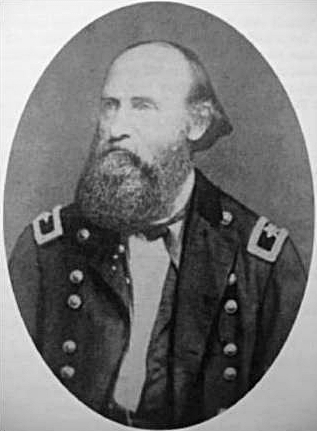I know that the American Civil War is probably quite a bit overdone on this site but hopefully this is a unique premise and twist as I've been pondering about making a timeline out of this down the road.
Anyway, I figured that while the idea is fresh, why not have a discussion about feasibility and possible ramifications?
Indiana during the American Civil War was a majorly rural 'western' state that was the first 'western' state to mobilize for the Civil War, ranked second among the Union States in the percentage of men of military age who served, its railroad hubs and access to the Ohio River was key to the Union war effort, and of course, provided crops since the majority of the south, well, seceded.
Ambrose Burnside was a Hoosier by birth and grew up in Indiana before eventually becoming the first President of the American National Rifle Association Post-War and the NRA was formed due to lackluster marksmanship training of Union troops during the war.
But what-if there was at least some effort to improve marksmanship training i.e adoption of the Hythe Method? What if at least one of the most Pro-Union states during the American Civil War decided to implement a similar program when war seemed all but inevitable?
What if Oliver P. Morton stumbled upon a copy of the Hythe Manual say, either sometime in 1858 or after being inaugurated Governor in early 1861, that was wrap around a newspaper article about the Whitworth Rifle?
And he pushed for and pulled strings to get the training implemented for the Indiana Legion and Volunteers?
Imagine the 19th Indiana Volunteer Regiment of the Iron Brigade at Gettysburg being detached to act as Sharpshooters against Henry Heth's men, in order to rain down fire against the Confederates who already endured the onslaught of Buford's Cavalry's breechloaders?
Imagine Joseph Whitworth being encouraged to set up a factory in Indianapolis manufacturing Whitworth Rifles (though of course even though it's a bit outlandish, I'm keeping my options open). Or Hiram Berdan being hired as an adviser?
As a reenactor who does a Billy Yank infantry impression and being a ACW buff, hopefully this is not ASB. I'm aware that there was a rifle shortage during the early years of the war, the engagement ranges being only less than 300 yards, even less, due to outdated Napoleonic tactics and I know that the Whitworth was expensive as hell but who knows, maybe some of the Confederate states will realize that Indiana is deadly serious on not allowing good old Southern boys getting the best of them.
One potential ramification I can think of is that after the war, Hoosiers might have a headstart in hunting herds of Buffalos with Buffalo Rifles out West!
Let's make the boyhood home of Honest Abe Lincoln feared for crackshooting even up to the Korean War a century later but that might be too ambitious
Oh and due to being within the German Belt: Indiana über alles!
Anyway, I figured that while the idea is fresh, why not have a discussion about feasibility and possible ramifications?
Indiana during the American Civil War was a majorly rural 'western' state that was the first 'western' state to mobilize for the Civil War, ranked second among the Union States in the percentage of men of military age who served, its railroad hubs and access to the Ohio River was key to the Union war effort, and of course, provided crops since the majority of the south, well, seceded.
Ambrose Burnside was a Hoosier by birth and grew up in Indiana before eventually becoming the first President of the American National Rifle Association Post-War and the NRA was formed due to lackluster marksmanship training of Union troops during the war.
But what-if there was at least some effort to improve marksmanship training i.e adoption of the Hythe Method? What if at least one of the most Pro-Union states during the American Civil War decided to implement a similar program when war seemed all but inevitable?
What if Oliver P. Morton stumbled upon a copy of the Hythe Manual say, either sometime in 1858 or after being inaugurated Governor in early 1861, that was wrap around a newspaper article about the Whitworth Rifle?
And he pushed for and pulled strings to get the training implemented for the Indiana Legion and Volunteers?
Imagine the 19th Indiana Volunteer Regiment of the Iron Brigade at Gettysburg being detached to act as Sharpshooters against Henry Heth's men, in order to rain down fire against the Confederates who already endured the onslaught of Buford's Cavalry's breechloaders?
Imagine Joseph Whitworth being encouraged to set up a factory in Indianapolis manufacturing Whitworth Rifles (though of course even though it's a bit outlandish, I'm keeping my options open). Or Hiram Berdan being hired as an adviser?
As a reenactor who does a Billy Yank infantry impression and being a ACW buff, hopefully this is not ASB. I'm aware that there was a rifle shortage during the early years of the war, the engagement ranges being only less than 300 yards, even less, due to outdated Napoleonic tactics and I know that the Whitworth was expensive as hell but who knows, maybe some of the Confederate states will realize that Indiana is deadly serious on not allowing good old Southern boys getting the best of them.
One potential ramification I can think of is that after the war, Hoosiers might have a headstart in hunting herds of Buffalos with Buffalo Rifles out West!
Let's make the boyhood home of Honest Abe Lincoln feared for crackshooting even up to the Korean War a century later but that might be too ambitious
Oh and due to being within the German Belt: Indiana über alles!



